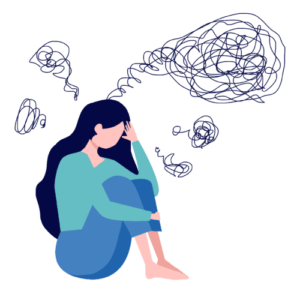
Transgender OCD Assessment
Answer these simple questions to understand more about Transgender OCD Assessment. We share instant results and keep your information confidential.

What is Transgender OCD Assessment?
Transgender OCD assessment involves evaluating individuals who experience intrusive and distressing thoughts related to their gender identity. It focuses on distinguishing between genuine gender questioning and obsessive doubts. Clinicians assess the nature and intensity of obsessions, compulsions, and distress, considering if these thoughts interfere with daily life and well-being. Accurate diagnosis and appropriate treatment are essential for supporting individuals with transgender OCD. Therapy, often utilizing Cognitive Behavioral Therapy (CBT) techniques like Exposure and Response Prevention (ERP), can help manage the distress caused by these obsessions and alleviate their impact on the individual’s gender identity experience.
Who can benefit from this Transgender OCD Assessment?
The Transgender OCD Assessment can benefit individuals who experience intrusive and distressing thoughts related to their gender identity. This assessment is designed to help those who may be struggling with Obsessive-Compulsive Disorder (OCD) symptoms specifically focused on transgender or gender-related themes. It provides a structured way to assess the presence and severity of these obsessions and compulsions, aiding mental health professionals in tailoring effective treatment plans. By addressing the unique challenges faced by individuals with Transgender OCD, this assessment contributes to more accurate diagnosis and targeted interventions, ultimately improving the well-being and quality of life for transgender individuals struggling with OCD.


Transgender OCD Assessment Accuracy
Transgender OCD, also known as gender dysphoria OCD or transgender identity OCD, involves obsessive thoughts about one’s gender identity. These thoughts can cause distress and compulsive behaviors like seeking reassurance or analyzing one’s feelings. It’s crucial to differentiate between genuine gender exploration and OCD-driven doubts. A qualified mental health professional experienced in both OCD and transgender issues can assess accurately. OCD assessments should consider the distressing impact on daily life, the presence of obsessions and compulsions, and the individual’s overall well-being. Accurate assessment aids in appropriate treatment planning tailored to the individual’s needs.
Types of Transgender OCD Assessment
Emotional Distress:
Assessing the level of distress caused by the obsessions and compulsions is important. Transgender OCD can cause significant emotional pain and anxiety.
Awareness of Irrationality:
Many individuals with OCD are aware that their thoughts are irrational, but they still experience distress. The assessment might explore the individual’s insight into the irrational nature of their obsessions.
Avoidance and Safety Behaviors:
Identifying avoidance behaviors or safety behaviors that the individual engages in to manage their anxiety can provide insight into their coping mechanisms.
Mental Health History:
Understanding the individual’s history of mental health issues, including any prior experience with OCD or anxiety disorders, can help in diagnosing and providing appropriate treatment.
Suicidal Ideation and Self-Harm:
Assessing any potential risk of self-harm or suicidal ideation is essential for safety and immediate intervention if necessary.
Cultural and Societal Factors:
Taking into consideration the individual’s cultural background, societal context, and experiences related to their gender identity is important for providing culturally sensitive care.
Handling Transgender OCD Issues
Transgender OCD, also known as Trans OCD or Gender Dysphoria OCD, is a specific subtype of Obsessive-Compulsive Disorder (OCD) where individuals experience obsessions and compulsions related to their gender identity. These obsessions can involve doubt, uncertainty, and distress about one’s true gender, leading to compulsive behaviors aimed at seeking reassurance or validation.
Here are some suggestions for handling transgender OCD issues:
- Recognize the Obsessions: Understand that the intrusive thoughts and doubts you’re experiencing are a result of OCD. These thoughts are not reflective of your true identity but rather a manifestation of the disorder.
- Educate Yourself: Learn about transgender experiences, gender identity, and the nature of OCD. Understanding the difference between genuine gender exploration and OCD-driven thoughts can help you differentiate between the two.
- Seek Professional Help: Work with a mental health professional who has experience in treating OCD and is knowledgeable about LGBTQ+ issues. They can provide you with targeted therapy, such as Exposure and Response Prevention (ERP) specifically tailored to transgender OCD.
- Avoid Reassurance-Seeking: One of the compulsions associated with transgender OCD is seeking reassurance from others about your gender identity. This can provide temporary relief but reinforces the cycle of OCD. Practice resisting the urge to seek reassurance.
- Mindfulness and Acceptance: Practice mindfulness and acceptance techniques to help you observe your thoughts without judgment. This can help reduce the distress associated with intrusive thoughts.
- Challenge Cognitive Distortions: Identify and challenge cognitive distortions that fuel your obsessions. For example, you might notice black-and-white thinking or catastrophizing. Question the validity of these thoughts.
- Exposure Exercises: Gradually expose yourself to situations or thoughts that trigger your obsessions without engaging in compulsive behaviors. Over time, this can help desensitize you to the anxiety associated with these thoughts.
- Build a Support Network: Connect with supportive friends, family members, or LGBTQ+ community groups. Sharing your experiences with others who understand can provide validation and a sense of belonging.
- Self-Expression: Explore your gender identity in a way that feels authentic to you. This might include trying new clothing, hairstyles, or names, without overthinking or analyzing every detail.
- Set Healthy Boundaries: Establish boundaries with individuals who may not understand your experience or who trigger your obsessions. Prioritize your well-being and mental health.
- Self-Care: Engage in self-care activities that bring you joy and relaxation. Taking care of your overall well-being can help manage stress and anxiety.
- Professional Advocacy: If you feel misunderstood by a mental health professional, don’t hesitate to seek a second opinion or find a therapist who specializes in OCD and LGBTQ+ issues.
Remember that managing transgender OCD takes time, patience, and support. You are not alone, and seeking help from professionals who understand both OCD and LGBTQ+ experiences can make a significant difference in your journey towards managing and overcoming this form of OCD.